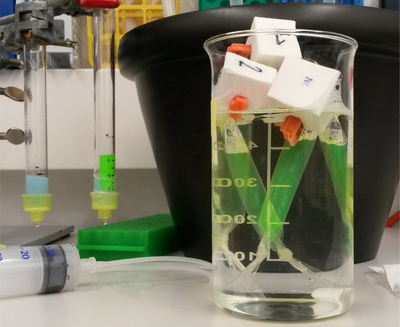We have a particular expertise in the areas highlighted below for which we developed dedicated enabling technologies.
Mechanistic and structural studies of membrane proteins require their stabilization in specific conformations. Single domain antibodies are potent reagents for this purpose, but their generation relies on immunizations, which impedes selections in the presence of ligands typically needed to populate defined conformational states. To overcome this key limitation, we developed an in vitro selection platform based on synthetic single domain antibodies named sybodies. To target the limited hydrophilic surfaces of membrane proteins, we designed three sybody libraries that exhibit different shapes and moderate hydrophobicity of the randomized surface. A robust binder selection cascade combining ribosome and phage display enabled the generation of conformation-selective, high affinity sybodies against an ABC transporter and two previously intractable human SLC transporters, GlyT1 and ENT1. The platform does not require access to animal facilities and builds exclusively on commercially available reagents, thus enabling every lab to rapidly generate binders against challenging membrane proteins.


The key function of many proteins that reside in the lipid membranes of cells is the transport of solutes. Although some functional properties of transport proteins can be determined using detergent-solubilized protein, the study of its translocation activity has an absolute requirement for a two-compartment system. Apart from transport studies, there might be other incentives to analyze membrane proteins in their membrane-inserted state, as the lipid membrane constitutes the native environment of membrane proteins. Although crude cell membranes may suffice for initial characterization of transport proteins, for more detailed analysis an isolated system is required in which parameters can be varied systematically. The first step for the in vitro analysis of membrane proteins is the insertion of the purified protein in an artificial lipid membrane, a process called membrane reconstitution.
Escherichia coli is one of the most widely used expression hosts for membrane proteins. However, establishing conditions for its recombinant production of membrane proteins remains difficult. Attempts to produce membrane proteins frequently result in either no expression or expression as misfolded aggregates. We developed an efficient pipeline for improving membrane protein overexpression in E. coli that is based on two approaches. The first involves transcriptional fusions, small additional RNA sequences upstream of the target open reading frame, to overcome no or poor overall expression levels. The other is based on a tunable promoter in combination with a fusion to green fluorescent protein serving as a reporter for the folding state of the target membrane protein. The latter combination allows adjusting the membrane protein expression rate to the downstream folding capacity, in order to decrease the formation of protein aggregates. This pipeline has proven successful for the efficient and parallel optimization of a diverse set of membrane proteins.

Baculovirus-mediated expression in insect cells is a powerful approach for protein production. However, many existing methods are time-consuming, offer limited options for protein tagging, and are unsuitable for secreted proteins requiring proteolytic maturation, such as TGF-β family growth factors. To overcome the limitations of traditional baculovirus expression systems, we engineered “FlexiBAC”. This system allows recombinant baculovirus formation inside insect cells and reduces the time between initial cloning and protein production to 13 days. FlexiBAC includes 143 shuttle vectors that append combinations of purification tags, fluorescent markers, proteolytic cleavage sites, trafficking signals, and chemical conjugation tags to the termini of the target protein. This system also overexpresses recombinant furin convertase to allow efficient proteolytic processing of secreted proteins. We demonstrate that FlexiBAC can be used to produce high levels of mature, active forms of TGF-β family growth factors, such as Activin A, as well as other proteins that are typically difficult to reconstitute, such as proteins rich in coiled-coil, low complexity, and disordered domains. FlexiBAC is a protein expression system for production of both cytosolic proteins and secreted proteins that require proteolytic maturation. The design of FlexiBAC and its expansive complementary shuttle vector system reduces cloning steps and simplifies baculovirus production.